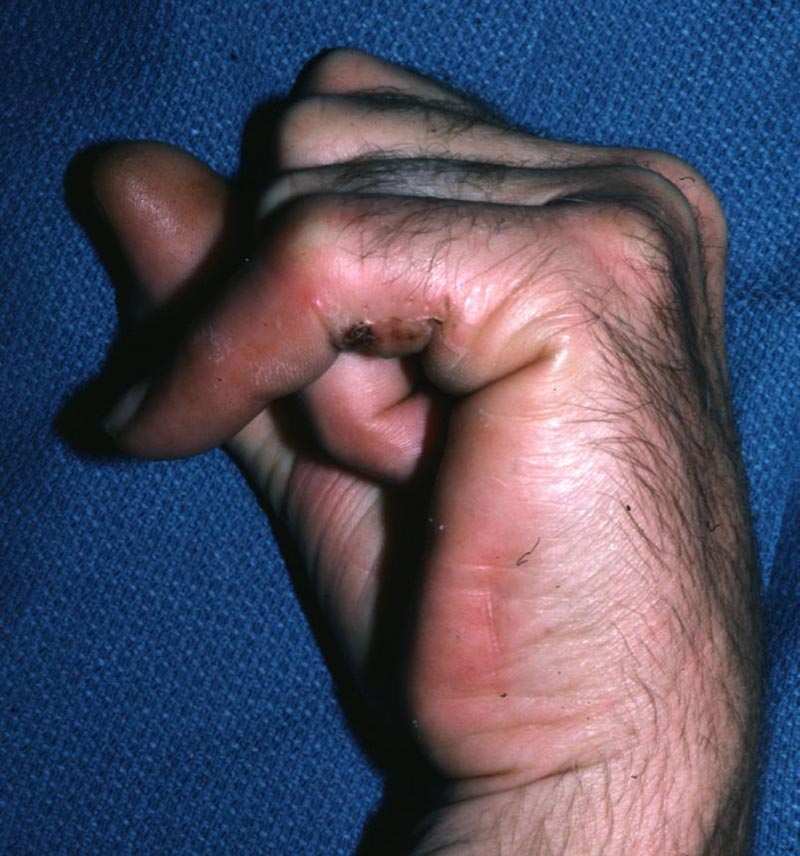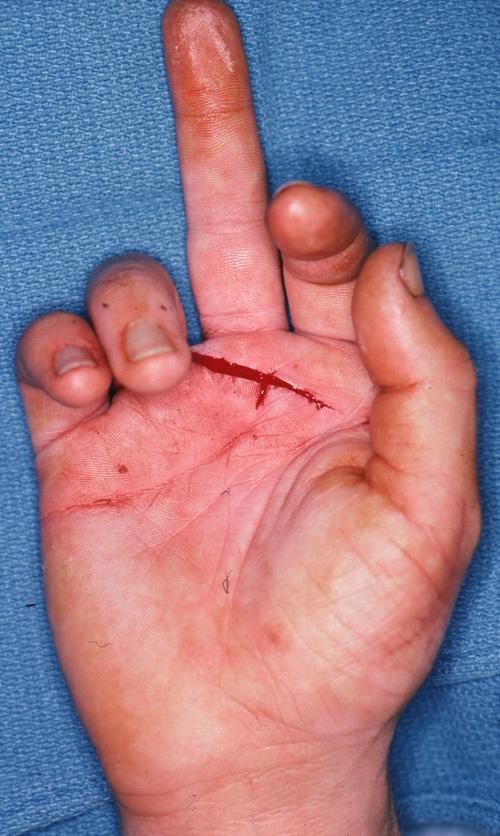
Flexor Tendon Lacerations
Flexor tendon injuries can be devastating, life-changing events. The flexor tendons are the structures in the palm of the hand and the palmar side of the finger that flex or bend the fingers and thumb. Tendons are like ropes that connect the muscles to the finger bones. If a flexor tendon gets cut, it’s a big problem. It seems like it should be easy to repair the tendon and get a good result, but it’s not. The problem is that the tendon runs through a tunnel, called the ‘flexor sheath’. It’s a snug fit, so there’s no room left for sutures, swelling from a repair, or scar tissue. And without the flexor sheath the tendon won’t work right. Depending on where it’s cut, the flexor tendon can only live for 2 to 6 weeks before it dies, liquefies and becomes irreparable. So tendon lacerations need to be addressed fairly quickly.
Flexor Tendon Repair
However, tendon repair surgery does not have to be performed as an emergency. It’s often best to let the wound ‘settle down’ for a few days before reopening it surgically. Tendon lacerations are optimally repaired within 2 weeks, although due to people coming to the hand surgeon late they’re often repaired after that. When the tendon is cut and retracts, there’s nothing in the sheath (tunnel) to keep it open, and the tunnel narrows. If the flexor tendon isn’t repaired within two weeks, the narrowed tunnel pinches the repaired tendon, making it more likely that the tendon will get stuck in the tunnel after surgery. Because of this, and the fact that there is more scar formation after two weeks, it becomes more difficult to regain motion after tendon repair, and increases the chance that a second surgery will be required after 3-4 months to regain motion. While surgical repair is still helpful after 4 weeks, the chances of stiffness and the necessity of a second surgery to regain motion are even greater. After 6 weeks in an adult, tendon repair may not be possible.
Any finger nerves that have been cut can be repaired at the same setting. If only one of the finger’s two arteries is cut, it is usually not repaired because the back-flow from the other, intact, artery will cause it to clot and occlude.
Sometimes the tendon gets ripped off the bone, classically when grabbing someone’s shirt or jersey to pull or tackle them during an athletic event. For many reasons, these flexor tendon ruptures usually affect the ring finger. Because flexor tendons can only live for so long before they are no longer repairable, people who wait too long to see if the finger “heals on its own” often miss their chance to get it repaired. Then they need even more complex reconstructions to improve finger function, or need to live their life with a weak finger that doesn’t fully bend and a permanent loss of grip strength. (Figures 8 & 9)
Flexor tendons are best repaired by hand-fellowship trained surgeons. The surgery is not very painful. However, the hand therapy after surgery is very intensive, is a ‘big deal’, and can take over a person’s work/school schedule for weeks after surgery. However, it’s very necessary and the surgery will not work without the therapy. In fact, this therapy can be even more important than the surgery.
Therapy should start roughly 2 days after surgery. If your surgeon wants to fix your tendon and then cast or splint you without allowing finger motion for over a week after surgery, find another surgeon because he/she is simply not current, and that finger’s motion may be permanently compromised with permanent stiffness. While people worry about re-tearing the tendon after repair, with a good modern 6-strand repair with an extra running (epitendinous) stitch around the tendon, retears are uncommon. Older 2 or 4 strand repairs weren’t as strong, leading to more frequent ruptures and more reluctance on the part of the surgeon and therapist to move the finger quicker. With modern techniques, stiffness is, by far, more common than failure of the tendon repair.
Hand Therapy is 3-4 days/week for at least 4 weeks. A ‘dynamic flexion’ splint with rubber bands that pull the finger down is worn for 4 weeks to allow the finger to move without stressing the tendon repair. There’s no functional use of the finger for 4 weeks following surgery, no light lifting for 3 months and no heavy lifting for 4 months.
After surgery, the wound should be kept clean and dry for 3 days. Bathing is safer than showering because the hand can be kept out of the bathtub. Wrap a towel around the hand and then place it inside a plastic bag secured with rubber bands. If a bathtub is not available, the best cast protector is made by Walgreens. After 3 days, the wound can get wet in the shower, blotted dry, and band-aids or a light dressing that will not limit motion can be applied. Please do not get the wound dirty or submerge it under water until the stitches come out, 2-3 weeks after surgery.
Because the tolerances in the tunnel are tighter and even a little scar can ‘jam up’ the tendon mechanism, results in the small finger are often not as good as for the other fingers. And the small finger is the most important finger to have good motion in for power grip; hold your small finger straight and try to make a tight fist and you’ll see what I mean.
If stiffness occurs, another surgery for scar removal, called a ‘tenolysis’, or exploring the option of surgery which, may be performed after 3-4 months. However, the results are clearly better if good motion is regained after a tendon repair without the need for additional surgery.
As with many aspects of Orthopedic Surgery, modern understanding and techniques, along with technology, have greatly improved our ability to help patients. And despite all of the difficulties inherent in treating flexor tendon injuries, with a team consisting of a good hand surgeon teamed with a good certified hand therapist and a motivated and compliant patient, very good results can usually be achieved.


